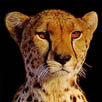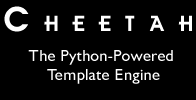Cheetah is an open source
template engine and code generation tool, written in Python. It can be used standalone
or combined with other tools and frameworks. Web development is its
principle use, but Cheetah is very flexible and is also being used to
generate C++ game code, Java, sql, form emails and even Python code.
Cheetah has a large and active user community. Products built with
Cheetah are used by many of the Fortune
500. One prominent new user is reddit.com, a startup funded by Paul
Graham. It has over 50,000 unique visitors a day.
|
“I'm enamored with Cheetah”
- Sam Ruby,
senior member of IBM's Emerging Technologies Group & director of Apache Software Foundation
“Give Cheetah a try. You won't regret
it. ... Cheetah is a truly powerful system. ... Cheetah is a serious
contender for the 'best of breed'”
- Alex
Martelli, Google uber techie, core Python developer
& author of several popular Python books
read more quotes
|
Download Cheetah 2.0.1
(released on November 16, 2007: minor bug fix).
Cheetah:
- is supported by every major Python web framework.
- is fully documented and is supported by an active user community.
- can output/generate any text-based format.
- compiles templates into optimized, yet readable, Python code.
- blends the power and flexibility of Python with a simple template language
that non-programmers can understand.
- gives template authors full access to any Python data structure, module,
function, object, or method in their templates. Meanwhile, it provides a way
for administrators to selectively restrict access to Python when needed.
- makes code reuse easy by providing an object-oriented interface to
templates that is accessible from Python code or other Cheetah
templates. One template can subclass another and selectively
reimplement sections of it. Cheetah templates can be subclasses
of any Python class and vice-versa.
- provides a simple, yet powerful, caching mechanism that can dramatically
improve the performance of a dynamic website.
- encourages clean separation of content, graphic design, and program
code. This leads to highly modular, flexible, and reusable site
architectures, shorter development time, and HTML and program code that is
easier to understand and maintain. It is particularly well suited for team
efforts.
- can be used to generate static html via its command-line tool.
What is the philosophy behind Cheetah?
Its design was guided by these principles:
- Python for the back end, Cheetah for the front end. Cheetah was
designed to complement Python, not replace it.
- Cheetah's core syntax should be easy for non-programmers to learn.
- Cheetah should make code reuse easy by providing an object-oriented
interface to templates that is accessible from Python code or other
Cheetah templates.
- Python objects, functions, and other data structures should be fully
accessible in Cheetah.
- Cheetah should provide flow control and error handling. Logic
that belongs in the front end shouldn't be relegated to the
back end simply because it's complex.
- It should be easy to separate content, graphic design, and program
code, but also easy to integrate them.
A clean separation makes it easier for a team of content writers,
HTML/graphic designers, and programmers to work together without stepping
on each other's toes and polluting each other's work. The HTML framework
and the content it contains are two separate things, and analytical
calculations (program code) is a third thing. Each team member should be
able to concentrate on their specialty and to implement their changes
without having to go through one of the others (i.e., the dreaded
"webmaster bottleneck").
While it should be easy to develop content, graphics and program code
separately, it should be easy to integrate them together into a website. In
particular, it should be easy:
- for programmers to create reusable components and functions
that are accessible and understandable to designers.
- for designers to mark out placeholders for content and
dynamic components in their templates.
- for designers to soft-code aspects of their design that are
either repeated in several places or are subject to change.
- for designers to reuse and extend existing templates and thus
minimize duplication of effort and code.
- and, of course, for content writers to use the templates that
designers have created.



